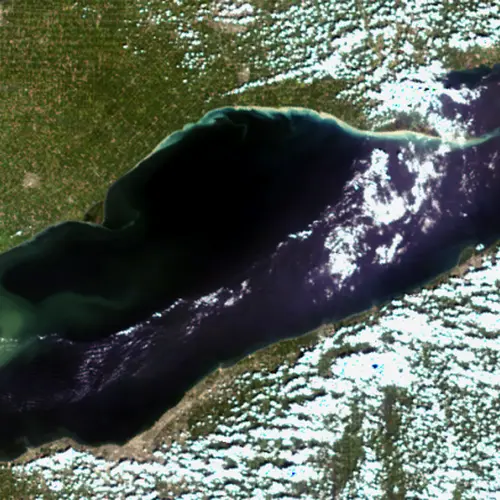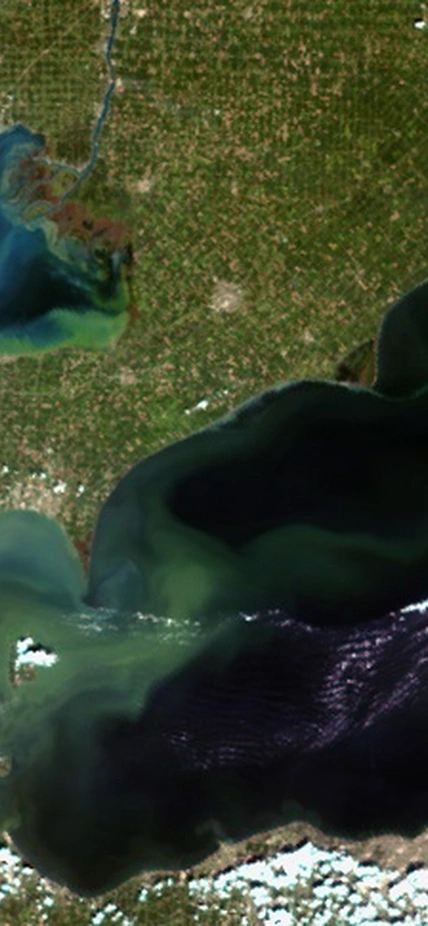New satellite data will mean more accurate and detailed Lake Erie Harmful Algal Bloom Forecast System
Washington, DC—NOAA and its research partners, including Carnegie's Anna Michalak and Jeff Ho, predict that western Lake Erie will experience a significant harmful algal bloom this summer, potentially reaching levels last seen in 2013 and 2014, though smaller than the record bloom of 2015.
This year’s bloom is expected to measure 7.5 on the severity index, but could range between six and 9.5. An index above five indicates a potentially harmful bloom. The severity index is based on a bloom’s biomass – the amount of its harmful algae – over a sustained period. The largest blooms, 2011 and 2015, were 10 and 10.5, respectively.
Early season projections from NOAA and its partners predicted a larger than normal bloom. This is the final seasonal forecast. The Lake Erie forecast is part of a NOAA ecological forecasting initiative that aims to deliver accurate, relevant, timely and reliable ecological forecasts directly to coastal resource managers and the public.
The size of a bloom isn’t necessarily an indication of how toxic it is. The toxins in a large bloom may not be as concentrated as in a smaller bloom. NOAA is currently developing tools to predict how toxic blooms will be.
“The Lake Erie harmful algal bloom forecast is another example of NOAA’s ongoing efforts to provide science-based information to water managers and public health officials as they make decisions to protect their communities," said Russell Callender, Ph.D., assistant NOAA administrator for the National Ocean Service. “We will continue to work with our partners to bring the most accurate data and tools to future forecasts for the region.”
First appear in late July
Recently, blooms have appeared in late July in the far western basin of Lake Erie, and increased in early August, although heavy rain in mid-July may push the late July bloom further into the basin. Calm winds tend to allow the algal toxins to concentrate, making blooms more harmful. Most of the rest of the lake will not be affected.
“A bloom of this size is evidence that the research and outreach efforts currently underway to reduce nutrient loading, optimize water treatment, and understand bloom dynamics need to continue,” said Christopher Winslow, Ph.D., director of the Ohio Sea Grant College Program. “Despite the predicted size of this year’s bloom, much of the lake will be algae free throughout the bloom season and the lake remains a key asset for the state.”
In addition to the seasonal forecast, NOAA also issues bi-weekly forecasts during the bloom season. This year, NOAA will begin incorporating additional satellite data into its Lake Erie Harmful Algal Bloom Forecast System that will enhance accuracy and detail. The data come from Sentinel-3, a new satellite that measures coastal water color as part of the European Union’s Copernicus program. NOAA’s Lake Erie HAB forecast bulletins are available online and by subscription.
New satellite to give more detail
“Sentinel-3 will provide additional detail and sensitivity, and it will assure our ability to assess the state of Lake Erie well into the next decade,” said Richard Stumpf, Ph.D., NOAA’s National Centers for Coastal Ocean Science’s lead for the seasonal Lake Erie bloom forecast. “A second Sentinel-3 will be launched later this year; the pair will assure that we can consistently see features that are one tenth the size of blooms we can see now.”
Nutrient load data for the forecasts came from Heidelberg University. The forecast models are run by NOAA’s NCCOS, the University of Michigan, North Carolina State University, LimnoTech, Stanford University, and the Carnegie Institution for Science. Field observations used for monitoring and modeling are done in partnership with NOAA’s Ohio River Forecast Center, NOAA’s National Centers for Coastal Ocean Science, NOAA’s Great Lakes Environmental Research Laboratory, NOAA’s Cooperative Institute for Great Lakes Researchoffsite link, Ohio State University’s Sea Grant Programoffsite link and Stone Laboratoryoffsite link, University of Toledooffsite link, and Ohio EPAoffsite link.

Caption: A satellite photo of Lake Erie in 2014 showing that year's algal bloom in the western basin. 2017's bloom is expected to resemble 2014's. Image is courtesy of NASA and NOAA.
